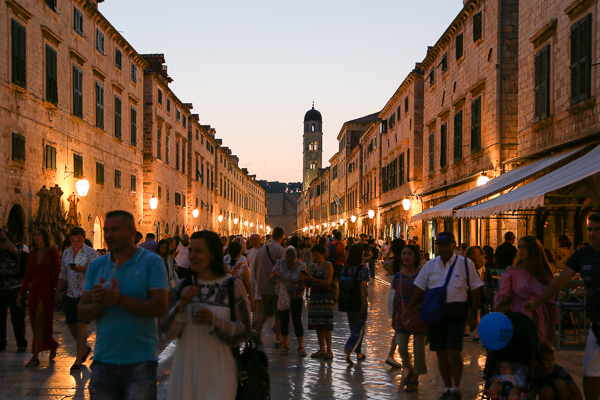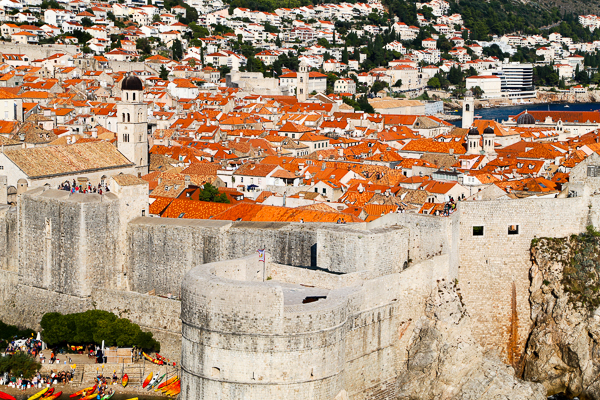
I had no idea of the effort it would take to snap this one postcard panorama of sunrise over the medieval city of Dubrovnik.
What was intended to be a 10 minute walk beyond the city walls turned into a 45 minute early morning hike to the hilly residential districts above town, just to find one unobstructed spot without trespassing into someone's private property.
For fellow travelers looking for the exact location of this photo, here is the Google Maps location and GPS Coordinate (N 42 °38'35.505 E 18 °7'7.188). You should find a gravel road that climbs above a small cliff to provide a clear view.

The sacrifices made that morning typified my experience of uncovering my favorite photo spots of Dubrovnik, long purported to be a photographer's mecca for its sea of checkered red rooftiles surrounded on all sides by medieval ramparts and mighty bastions. While nobody can refute its photogenic qualities, getting clear shots without its mind-blowing hordes of tourists was a whole different matter.

On a cruise ship day it may appear that the whole world has come to Dubrovnik, and for good reasons. Coined Pearl of the Adriatic by Lord Byron, declared a World Heritage Site by UNESCO and popularized by Game of Thrones and Star Wars as a filming locale, Dubrovnik has become the most popular tourist destination in the Balkans by a long shot, 20 years or so after that infamous siege during the Yugoslav Wars.

So we purposely avoided the peak of the tourist season, opting for two nights in mid September when the weather was still warm and the crowds were hopefully receding. That morning we took the highway bus in from neighbouring Montenegro, booking a car for an excursion to Ston the next day and picking up tickets for the third morning towards our next stop of Mostar.

But nothing prepared us for the shock of a Disneyland-like entrance check through Dubrovnik's majestic 16th century gate, as we shuffled behind hundreds of queuing tourists aiming to maximize their five hour mad dash through the sights before returning to their cruise ships for the night.
And the cruise ship terminal wasn't even full on this day.

This extreme crowding has been well-documented by the likes of The Daily Telegraph which sounded an alarm back in 2017 with its article "The Death of Dubrovnik." UNESCO has also raised concerns about the old town's sustainability as a World Heritage Site, and its dwindling population of 1,000 locals versus 1,000,000 plus visitors a year. That ratio is already more than two times worse than Venice and growing every year.

Now compare THIS with the previous photo of the multi-national hordes.
So yes, it is possible to enjoy Dubrovnik in its serene, unhurried authenticity that was the norm just a generation ago, before the onslaught of mass tourism in the form of Adriatic cruises. There are just two easy steps.

First you should stay for the night inside the old town. And second, you must wake up real early. I would suggest five in the morning if your body can handle it.
Do this, and it will open up a magical maze of noiseless, dimly lit alleys essentially untouched since the time of the medieval Republic of Ragusa.

Accommodations within the old town aren't cheap of course. In fact this was the second most expensive apartment of our journey through six Balkan countries despite the Spartan decor of this bachelor suite, double bed on one side of the kitchen counter and the sink on the opposite side. Thankfully the modern convenience of air conditioning and wifi -- and a washing machine! -- were available.

Evening strolls to the Rector's Palace became an after-dinner routine with our apartment situated just 250m away in a steep alley above Prijeko ulica. It was a minute's walk to the supermarket and a Mlinar Bakery, and five minutes to the bus stop outside the Pile Gate.

Just south of Rector's Palace is the dome of Dubrovnik's baroque cathedral, focal point of a renowned 1000-year-old parade acclaimed as UNESCO Intangible Cultural Heritage. The evening atmosphere was calmer than daytime, though it was nowhere as mesmerizing as the early morning.

This was the reward for waking up at 05:30 in the morning at the famous Prijeko ulica, epicentre of Dubrovnik's gastronomic scene swarming with herds of thirsty tourists every lunch and dinner hour. I had the luxury of several minutes -- rather than seconds during daytime -- to frame my favorite shot without any obstruction.

For once nobody stopped to admire the 16-faced fountain of Onofrio, Dubrovnik's 500-year-old landmark originally designed as the culmination of medieval aqueducts transporting water to the walled citadel from a dozen kilometres away.

Nothing was open at this hour aside from the 24 hour Mlinar Bakery on Stradun. Within the next 30 minutes the waiters would finish setting up the tables, and by 07:00 the alley would be filled with patrons arriving for their morning shots of crna kava.

Garbage collection and engineering trucks started showing up at 06:00 in front of St. Blaise, an 18th century reincarnation of a medieval church dedicated to the city's patron saint.

Caravans of delivery trucks arrived with fresh supplies of fish and bread for the high end restaurants on the main thoroughfare of Stradun. The city has now officially awaken, in preparation to be flooded with tourists again within the next two hours.

Long considered the beating heart of the old town, Gundulic Square has for centuries hosted the farmer's market for its bewildering assortment of local produce from fresh squash blossoms to aged Croatian grappa, all under the watchful eyes of the city's favorite poet.

At 07:30 the sun had just climbed over Mount Srd to paint the old town with a glorious golden hue. It took at least 40 minutes to find my desired panorama as mentioned above, starting out from the Ploce Gate, poking my nose past the cable car station and further up the steep alleys towards the highway at the top.

To truly appreciate the massive scale of the medieval fortifications one must spend time to hike these ramparts, 17 towers in all that defended its citizens not only against 16th century Turks, but as recently as the 1990s during the Siege of Dubrovnik by Yugoslav artillery.

Most visitors would agree that 90 minutes would be minimal for the breathtaking views of majestic crenellations and sea cliffs afforded by two kilometers of adjoined walls, especially in tourist season when the narrow medieval walls become clogged by masses of day-trippers from the cruise ship terminal.

We waited until the late afternoon before beginning our obligatory circumnavigation of the city walls, above the medieval skyline of St. Ignatius and the adjoining Jesuit college on one side and a deadly drop to the blue Adriatic on the other.

Apparently not everyone was averse to leaping into the crashing waves below. Makeshift bars dot the rocky shoreline beneath the walls, serving a youthful clientele inclined to enliven their pub crawl with a few cold swims in the Adriatic.

Arguably the best vista of Dubrovnik's impenetrable walls comes from the neighbouring castle of Lovrijenac, just 200m outside the Pile Gate atop a rocky promontory, next to the launch point for local kayaking tours. The combined entrance for the City Walls and Lovrijenac was about the only reasonable price tag in town, as we would soon be unpleasantly surprised for dinner.

As usual our criteria for meals are quite simple: give us authentic local dishes at a budget that locals can afford. Unfortunately at Dubrovnik the locals are quickly becoming extinct as discussed above, making our goals somewhat unrealistic.

At Lucin Kantun (see map) we came to sample what was rumoured to be one of the better deals among Dubrovnik's abundance of premium priced restaurants. A dish of oven baked octopus in tomato paste sounded very reasonable at 110 kuna or 15 euros, until it turned out to be a tapa sized dish of four small pieces of tentacles.

This appetizer of stuffed squids was almost a better value at just 45 kuna (6 euros) for a slightly smaller portion. Like the baked octopus above the taste was pleasant but bordering on being unmemorable.

Nothing summed up our first meal in town like the bite-sized Lamb Brochettes with Lavender Honey, well-flavoured but astoundingly miniscule in portion for its price. Fortunately the lavender honey turned out excellent as a spread for the bread, as I was barely half full without it.
Meal for Two Persons
| Lamb Brochettes with Lavender Honey | 45 Kuna |
| Stuffed Squids | 45 Kuna |
| Baked Octopus in Tomato Sauce | 110 Kuna |
| Glass of Table White | 25 Kuna |
| Bottle of Water | 26 Kuna |
| TOTAL | 251 Kuna (CAD$51.2) |

Craving for heartier portions at dinner time we visited the midmarket fast food joint of Barba (see map), famous among tourists for turning the traditional street grub of fried anchovies and burgers into seafood platters, still relatively affordable compared with neighbouring restaurants. Featuring a full octopus burger on a squid ink bun, octopus salad, calamari, anchovies and battered shrimp, it was more food than we could finish for a price (299 kuna or 41 euros) steeper than any burger platter I have ordered anywhere in the world.
Meal for Two Persons
| Platter for Two | 299 Kuna |
| Bottle of Karlovacko x 2 | 72 Kuna |
| TOTAL | 371 Kuna (CAD$75.7) |

So we learned our lesson and ordered cheap Cevapi sandwiches for take-out the next day, and better yet, got out of Dubrovnik and explored its spectacular countryside with a rental car. At the nearby towns of Ston and Mali Ston we enjoyed an extraordinary hike along with one of our most memorable seafood meals, to be reviewed in the next post.
IF YOU GO
Dubrovnik's airport is conveniently served by low-cost carriers such as EasyJet and Jet2. For travelers planning a wider Balkan road trip like we did, highway buses from Kotor (3.5 hours), Mostar (4 hours), Split (4.5 hours) etc. arrive at the long distance bus station near the cruise terminal, a quick 15 minute ride on local buses to the Pile Gate bus stop just outside the old town.





















